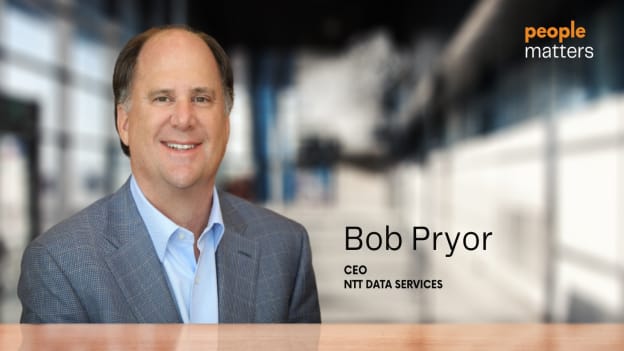Navigating Disruption: A conversation with NTT DATA Services CEO, Bob Pryor

As economic headwinds continue to batter the tech industry, NTT DATA Services’ CEO Bob Pryor remains steadfastly focused on strategic growth and innovation. In an exclusive interview, Pryor, an industry veteran with over three decades of leadership experience, outlined his playbook for guiding the global IT services provider through today's challenges.
"At the heart of opportunity, for both individuals and organisations, lies growth," Pryor asserts. "Stagnation breeds stagnation, while progress paves the way for progress. That's why prioritising growth isn't just about numbers; it's about investing in people, unlocking global talent pools, and identifying new areas for development," said Pryor, who previously served as CEO of Fujitsu Americas and held senior roles at EDS, Ernst & Young, Capgemini, HP and more before joining the Japanese IT giant.
Pryor highlighted how emerging technologies like AI and quantum computing align with NTT DATA's emphasis on sustainability and efficiency. He also revealed plans for major investments in India, including expanding the workforce by up to 20,000 employees.
Here are the edited excerpts:
Mastufa: As a global tech leader, how do you perceive the current tech industry landscape, especially in the post-pandemic era with lingering uncertainties?
Bob: Over the past few years, there's been a significant shift towards helping companies modernise their technology environments and embrace digital transformation to enhance experiences for customers, employees, and stakeholders. This has spurred a substantial migration to the cloud. Presently, the emphasis is on the importance of multi-cloud environments and proximity to companies, network centres, and compute intensity without latency—a notable shift. Another major focal point is AI, particularly generative AI. These three overarching themes not only dominate conversations but also drive investment strategies.
Generative AI marks a new phase, thanks to better chips and computing power. Emerging tech like quantum computing is adding to the excitement for what comes next.
While the impact of generative AI is a subject of debate, its significance is universally acknowledged. Over the last decade, substantial investments have gone into automating performance through RPAs, orchestrators, advanced AI, and machine learning. This automation push positions us to the next level, automating intricate environments and situations. Each company needs to determine its priority use cases, but significant themes for AI applications include software engineering, product engineering, sales, and marketing.
Clients are also grappling with economic volatility, uncertainty in the U.S., record-high interest rates, inflation concerns, and geopolitical uncertainties. This cautious environment influences their investment and spending decisions.
Mastufa: With the industry witnessing substantial job losses over the past 12 months and a focus on cost efficiency, how do you balance cost-cutting measures with maintaining employee morale and productivity?
Bob: The primary driver of opportunities for people, both within companies and across countries, is growth. Stagnancy in driving efficiencies often leads to inevitable layoffs. However, when growth is prioritised, creating more opportunities for individuals becomes the focus. This involves not only driving automation efficiencies but also leveraging global delivery, tapping into talent in cost-advantageous locations like India, and crucially, finding new areas of growth for career development. Training and developing employees for new skills play a significant role in this strategy, ensuring continuous skill development across all levels of the labour pyramid.
While we may be experiencing slightly lower growth in the market today, the remarkably low unemployment rate indicates a dynamic job market with people changing jobs. There's still a considerable demand for hiring, training, skilling, and employing individuals, both to backfill existing roles and to support emerging growth areas. The model operates efficiently, similar to stock trading, where there's always a buyer and a seller. In this context, there is a perpetual demand for people with the skills we're either training, developing, or actively hiring for. This reality holds particularly true in India, where the unemployment rate remains remarkably low despite the ongoing challenges.
Our parent company, NTT, is introducing a new large language generative AI model Tsuzumi, launching in the coming months.
Also Read...
- Trials to Trends: Is the four-day workweek here to stay?
- Musk's 'X'ploration of Twitter: A twisty tale
- A conversation with HP Singapore MD Fiona Lee
Mastufa: Are businesses really getting better at upskilling to fill the gaps?
Bob: It's tough, and honestly, we're not upskilling as fast as needed. But we're investing heavily in training at all levels, focusing on advanced technologies and high-demand skills. Retaining talent means helping them grow in complex roles. For instance, in healthcare, AI enhances the work of top oncologists. The challenge is keeping up with tech advancements and ensuring our workforce can effectively use them. We need people who can ask the right questions, analyze data, and communicate effectively—essential skills in today's workforce.
Mastufa: How much of the discourse around Gen AI do you think is just hype? We often come across reports on potential use cases and organisational experiments. Do you see tangible progress, or is it too early?
Bob: Similar to any new innovation, there's the infamous hype cycle—initial excitement and attention, followed by a period of disappointment, and eventually uncovering the underlying trends supporting the original premise. Two decades ago, cloud technology faced a similar hype, and today it's ubiquitous. The same trajectory applies to AI. While algorithms have been in development for over 30 years, generative AI represents a new phase. Advancements in underlying technologies, such as chips and computing power, alongside emerging technologies like quantum computing, are aligning to support the next wave. There's tremendous excitement and enthusiasm, but the key lies in identifying specific use cases. For instance, in sales and marketing, AI can enhance understanding of client behaviours, needs, and priorities, enabling precise targeting. In software engineering and product management, automated tools continue to improve. The impact of AI is substantial and tangible when applied to specific use cases, driving productivity, quality, reliability, and speed. It's crucial for technologists to focus AI in areas that yield meaningful impact. Search, a familiar aspect of our lives driven by AI, is evolving at both internet and corporate levels, offering powerful capabilities for locating specific, complex data and making informed decisions. Ultimately, the intersection of AI and data holds immense promise for driving better decision-making—a truly exciting area of innovation.
Mastufa: Could you share more about your AI strategy and current experiments? Anything specific you'd like to highlight?
Bob: Sustainability is a significant concern, particularly in reducing our carbon footprint and energy consumption. AI, despite its benefits, poses challenges due to increased computing requirements. One of our key focuses is finding more efficient ways to support AI's energy needs, aligning with broader sustainability goals.
Our focus in 2024, NTT is helping clients through economic uncertainties, by boosting cost efficiency and simplification of large enterprise operations.
AI is instrumental in developing technologies for efficient energy use and consumption, aiding in reducing our energy footprint. Through AI, we aim to enhance demand and energy management, leveraging its capabilities to drive efficiency despite its energy consumption. In software development and engineering, our AI tools turbocharge productivity, elevating efficiency by 10%, 20%, or even 30%. Beyond cost-effectiveness, they fuel creative growth, unlocking new possibilities.
In our extensive BPO business, we employ a large number of robotic process agents (RPAs) to automate back-office processes for various industries. While not generative AI, this form of automation is highly effective, with the impact equivalent to a sizable engineering centre.
Cybersecurity is another critical area where AI plays a pivotal role in safeguarding environments, protecting data, and ensuring privacy at both individual and corporate levels. As we face evolving cyber threats, AI becomes an indispensable tool in creating safer digital landscapes.
Mastufa: What can we expect from NTT DATA in 2024? Any significant developments on the horizon?
Bob: Our parent company, NTT, invests $3.6 billion in R&D annually and has exciting plans for 2024. They're introducing a new large language generative AI model, with the Japanese version launching in the coming months and an English version following in the middle of next year. This model, named Tsuzumi, promises remarkable improvements in accuracy, reliability, and energy efficiency compared to current tools like chatGPT.
Given our strong emphasis on sustainability, we've been actively investing in technologies to reduce energy consumption. We're working on a photonic technology called IOWN, which leverages light instead of electricity to significantly lower energy consumption in driving our technology. While IOWN is a longer-term project, Tsuzumi's imminent release in the next few months marks a major milestone for us in 2024.




